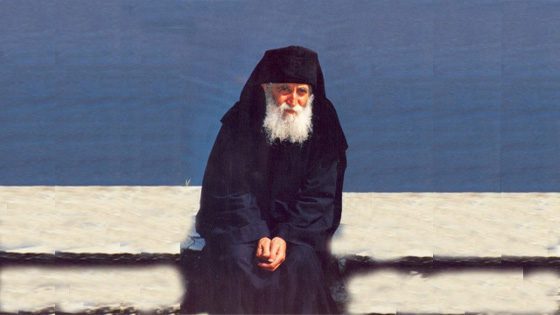St. Paisios & ‘Shamanistic’ Christianity

I’m re-reading a book that meant a lot to me when I was coming into Orthodox Christianity in 2006, but that I haven’t read since then: The Mountain of Silence, by Kyriacos Markides. It’s an introduction to Orthodox spirituality for laymen, as told by a “Father Maximos,” a monk from Mount Athos (he’s now a bishop: Metropolitan Athanasios of Limassol, Cyprus). The book was pretty mind-blowing to me back then. Now, after almost 12 years of Orthodoxy, it’s basic stuff, but still really well written.
Markides is a sociologist of religion at the University of Maine, and an Orthodox Christian born in Cyprus. Reading the book, you can tell that he’s coming off of his academic study of shamanic traditions, and is something of a New Ager. It’s very easy, though, to discern between what Father Maximos says, and what the author’s added comments are. I don’t know where Markides stands now on these issues. I do love this book, though.
I want to share with you a passage about the Elder Paisios — now St. Paisios, as he was canonized in 2015, 21 years after his death. He’s a famous contemporary monk of Mount Athos, known for clairvoyance and wonderworking. He is roughly to the Orthodox world what Padre Pio (now St. Pio of Pietrelcina) is to the Catholic world. He had visions of saints and angels fairly frequently. Here’s a passage about him from the Markides book:
In fact, one of the basic forms of training in Athonite spirituality is to learn how to develop diakrisis [discernment], to be able to differentiate that which comes from God from that which comes from Satan, who tries to confuse and disorient the soul aspiring for perfection. Elder Paisios’s experiences with revered spiritual beings [angels and saints — RD], similar to other stories that I had read or heard about on the life of saints and great prophets, would not fall under the category of hallucinations.
Hallucinations are not from God. Individuals who experience hallucinations later come to recognize them as hallucinations. Elder Paisios’s visitations were real and concrete happenings, as concrete as his speaking to ordinary pilgrims and visitors. Hallucinations normally involve confusion and sharp distortions of reality and perception. But Elder Paisios’s experiences, like other such reports, were lucid, orderly, and highly coherent. Hallucinations are furthermore accompanied by anxiety and mental disturbance. That was far from the case with this contemporary anchorite. On the contrary, these extraordinary experiences brought him exquisite feelings of peace and spiritual well being that had a transformative effect on his life.
I remember the reaction of Professor John Rossner after I narrated such stories from Mount Athos at a conference in Montreal on the interface between science and religion. As the moderator, he stood up and with a strong and authoritative voice he made some poignant observations:
“What you said about miraculous happenings on Mount Athos and other monasteries, of the manifestation of dead saints to the living and so on, is very important,” he stated. “This is the kind of thing that the early Church and Roman historians, including even the eighteenth-century skeptic Gibbon, have said: That early Christian literature claims that the Christian movement spread not because of teachings and preachings — they were not allowed to do that — but because people had mystical experiences in which the dead saints and martyrs appeared to the living and taught them about the reality of the spiritual world. This of course is not understood by contemporary Christianity very much. These monasteries and places out of the way are like preserves from history ,really! And as Kyriacos said, trying to bring forward this spiritual tradition is like bringing up something that is a lost treasure from the bottom of the ocean. … These kinds of events are indeed still part of the lives and traditions of contemporary monks and hermits of Eastern Christianity. And we don’t know this treasure is there. If you try hard enough you can find it in history books. Our problem is that theologians in the West are not learned enough in history to find it. And they don’t recognize that the origins of the Christian movement were spiritistic and shamanistic. And when the come across things like these in places like Mount Athos or in little villages in Russia or Greece, they can’t make sense of them. They are incapable of understanding why an old woman is considered a holy woman and the archbishop comes and sits at her feet in the village because she has had experiences of dead saints and angels and consequently becomes a channel of information. They can’t realize that that is the way Heaven talks to the living.”
The whole thing is in The Mountain of Silence.
Keep in mind that for the Orthodox, mystical events must be understood within the framework of received and valid Church teaching. If an Orthodox Christian claims some sort of mystical event is real, it must conform first to the teachings of the Church. It is not the case at all that any Orthodox Christian who says something mystical has happened to him or her is believed and validated.
I welcome your commentary, skeptical and otherwise, but let me caution you: St. Paisios is, for me and other Orthodox Christians, a holy man, and not to be mocked. I don’t object at all if you disbelieve in his testimony, or in this way of approaching the world. Seriously, I welcome your critical commentary. But I do insist that you express your skepticism respectfully in the comments. I won’t publish them otherwise.

Subscribe for as little as $5/mo to start commenting on Rod’s blog.